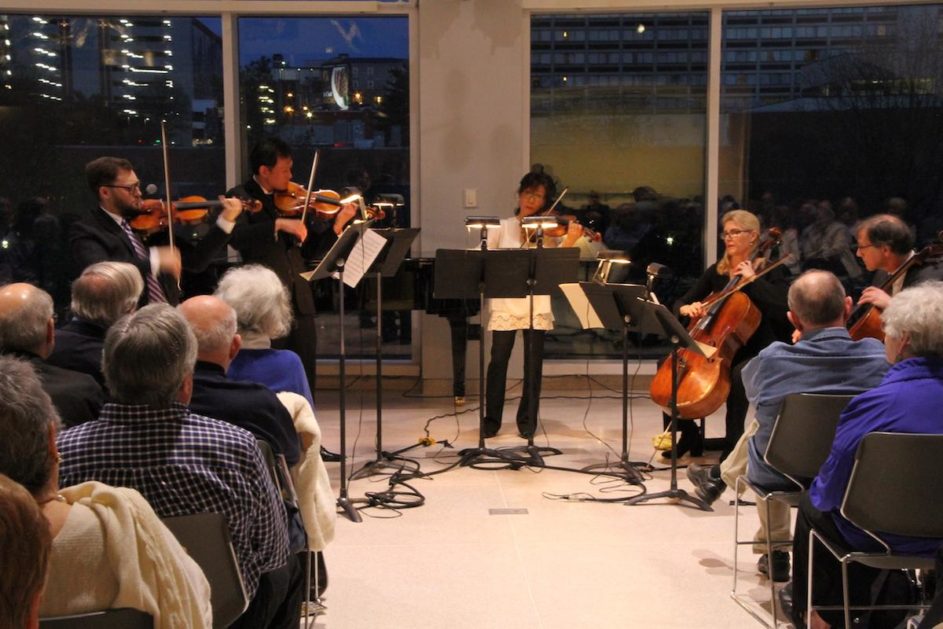There were a lot of interconnections in the music chosen by Knoxville Symphony Orchestra concertmaster William Shaub for this week’s concertmaster concert at the Knoxville Museum of Art, much of it having to do with opera, in one way or another, as pianist Kevin Class pointed out in his short talk about Mozart’s music.
Class and Shaub began with Fritz Kreisler’s “Tempo di Minuetto,” the full title of which includes the appendage “in the style of Pugnani” because Kreisler originally published the piece, and others, in the name of Gaetano Pugnani, the 18th-century violin virtuoso and composer. Kreisler eventually confessed the pieces were actually his own. Today, the appendage is usually dropped because few people know who Pugnani was.

KSO Concertmaster William Shaub and pianist Kevin Class play Fritz Kreisler’s “Temp di Minuetto” at KMA Wednesday evening.
Shaub and Class played it in an energized, dancing manner that fits the title when it is used as marking for how to play a movement in a composition, as it was in the second movement of Mozart’s “Sonata No. 21 for Piano and Violin in E Minor,” K. 304, which came a little later in the program. I suspect programming the Kreisler piece followed choosing the Mozart.
Mozart wrote the sonata in 1778 while on a trip to Paris, accompanied by his mother. She became ill and died. Her death is often pointed to as the source of the darker, minor-key mood of the sonata. Mozart had, more or less, been forced to make the trip by his father because much of the family’s welfare depended on Mozart’s fame. But in large part, the tone of the sonata likely reflects the double whammy of his mother’s death and the emotional upheaval of having had to leave behind Aloysia Weber, the woman Mozart had fallen in love with back in Mannheim.
For most piano and violin sonatas of this period, the piano was the star instrument, with the violin often assigned to a subordinate role. But the way Shaub plays, that would be less so because his playing is a full-body experience that goes well beyond just the sound of the instrument. One sees the music in the way Shaub’s physical expression captures what the music is doing. He visually gets the audience as involved as he clearly is.
In between the Kreisler and the E Minor sonata, Shaub and Class played Mozart’s earlier “Sonata No. 17 for Piano and Violin in C Major,” K. 296, written in 1778 before leaving Mannheim. One can tell by the mood of this sonata that it was a happier time for Mozart.
It is filled with bright, cheerful, giggling little trills in the piano and bouncy phrases in both instruments. There is also a more singing quality, gorgeously captured in Shaub’s violin. The little stops and starts in the music had a playfulness and sheer delight.
After intermission, when darkness had settled in, it was entirely fitting that Franz Schubert’s “String Quintet in C Major,” D. 956, Op. posth. 163, was played in an art museum. It is considered one of the greatest masterpieces of art, one of the most brilliant compositions in all of chamber music, alongside Beethoven’s late string quartets.
Shaub was joined by KSO colleagues violinist Gordon Tsai, violist Eunsoon Corliss and cellists Andy Bryenton and Stacy Nickell. Because Schubert added an extra cello to the standard string quartet instead of another viola, it is often referred to as Schubert’s “Cello Quintet.”
Written during the last couple of months of Schubert’s life in 1828, the quintet was not performed publicly until 1850. Wednesday’s performance was nothing less than sublime. The additional cello gave the piece an almost orchestral richness that had not been heard in string music before. The moments when Nickell’s cello and Corliss’ viola played textures that supported the lovely playing in the violins had the narrative quality of storytelling.
It was transporting music.
In Shaub’s hands, the Concertmaster Series has become the KSO’s finest offering among a group of concerts that are consistently captivating. The noontime Q Series is consistently good, as well. But one always has the sense that it is squeezed into a timeframe. Shaub’s concerts always have the feeling of music one wants to spend the entire evening with.
Bravo!
The program will be played again at 7 tonight at KMA. Call the box office at 865-291-3310 for tickets.
Information about KSO concerts coming up the rest of this season, including Saturday night’s live performance of the music in Disney’s “Mary Poppins,” with the film playing on a screen overhead, can be found here.

